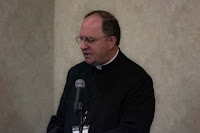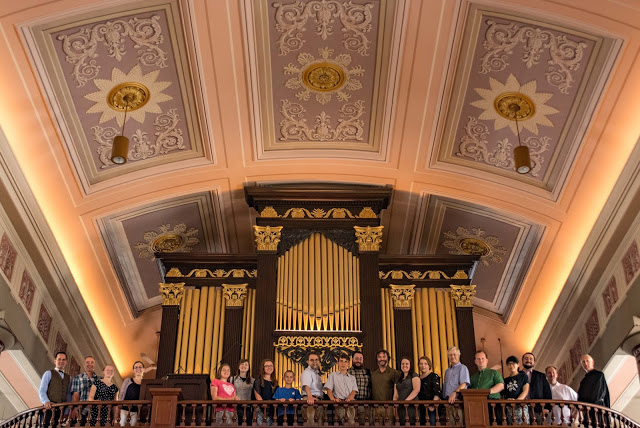[A few years ago, Dom Mark Kirby of Silverstream Priory preached a retreat to the nuns of the Monastère Saint-Benoît in Nans-sous-Sainte-Anne, France; here is his sermon on the occasion of All Saints’ Day. The translation is mine, and the original text in French appears on Dom Mark’s blog, Vultus Christi. — RC]
“Lord, this is the people that longs to see your face.”
Yes, Lord Jesus, they all came to seek your face.
They all took to heart this word which your Holy Spirit made King David the prophet sing: “My heart has said: I seek the Lord; it is your face, O Lord, that I shall seek. Turn not your face from me.” (Ps 27: 8-9)
They all became living mirrors of your Holy Face, as your Apostle says: “And we all who, with faces unveiled, reflect the glory of the Lord as in a mirror, are transformed into his very image, ever more glorious, as befits the work of the Lord who is the Spirit.” (2 Cor 3: 18).
Lord Jesus, the beauty of the glory of your saints ravishes us because it is the reflection on their faces of the beauty of the glory of your Face!
Today you reveal to us, today you tell us again the secret of all sanctity: to seek your face.
To anyone who seeks your face, Lord Jesus, you reveal it, and he to whom you reveal your face can only adore it.
This adoration of your Holy Face is transforming; it is again the prophet-king who gives us the words to sing each night: “Let the light of your face shine on us, O Lord.” (Ps 4, 7).
Among all these faces illumined by the beauty of your Face, there is one countenance radiant with a splendor that makes the sun pale.
It is the face of your Mother, the all-beautiful, the all-pure.
You are all beautiful, O Mary, for in your face we see the radiant reflection of Him who is “the brightness of the Father’s glory and the image of his being” (Heb 1:3).
You, the queen of all the saints, you are the great sign that appeared in the heavens: the Woman clothed with the sun, having the moon beneath her feet, and bearing a crown with twelve stars.
I must say to you, dear sisters, that since we sang the antiphon of the Magnificat at first Vespers, I have understood that the faith of Abraham remained, in a sense, unfulfilled, inasmuch as it had not yet found its fullness in Mary.
The sons and daughters of Abraham, more countless than the stars of heaven, are all without any exception, sons and daughters of Mary, of her who believed “that the word of the Lord to her would be fulfilled.” (Luke 1:45).
It is Mary who leads all the saints in the song that once poured out of her immaculate Heart: “The Almighty has done great things for me” (Lk 1:49).
This is the song of all the saints.
Each one receives it from the lips of Mary, to take it up in his own turn, each with his own voice, each with his own accent, each with the melody which the Holy Spirit inspires in him.
That is the great sound that fills Heaven: it is the song of Mary, taken up by the choir of the saints.
And who are these saints, all children of Mary?
They are the ones blessed by the gospel which you just heard.
This word of Jesus Crucified fits with each of the beatitudes: “Behold your Mother” (Jn 19:27), the testament of love entrusted to his beloved disciple.
So I should say: You poor of heart, behold your Mother, the Virgin of the poor as she appeared at Banneux, the Queen of the anawim, of those who depend on God for everything.
You meek, behold your Mother, Mary, the good shepherdess, whose care surpasses that of David, whose gentleness brings peace to our conflicts and calms all our tempests.
You who weep, behold your Mother, whom the Church, rich in the experience of two millennia, called Consolatrix Afflictorum, the Consoler of the Afflicted.
You who hunger and thirst for justice, behold your Mother, the Mother of the Eucharist, who gave of her own body and blood so that, from her virginal womb, made fruitful by the power of the Holy Spirit, the Body and the Blood of Christ would be offered to the whole world to satisfy you.
You merciful, behold your Mother, whom the Church, in that sublime song that rises from monasteries through the entire world each evening, calls Mater misericordiae.
Mary is not frightened at all at the sight of your sufferings.
She takes them all into her Heart to wash them in the oil and wine of the Holy Spirit.
You pure of heart, behold your Mother, Immaculate, all-beautiful, who works marvels in the hearts of sinners, marvels of purity and openness.
You peacemakers, behold your Mother, Regina pacis, who has never forgotten the angels’ song that traversed the stars on the night when she brought into the world the Prince of Peace: “Glory to God in the highest heavens, and peace on earth to the people he loves.” (Lk 2:14)
You persecuted for righteousness, behold your Mother, the Regina Martyrum, whose soul was transpierced by a blade of sorrow.
She remained standing by the cross of her Son.
She experienced all its bitterness and, with her crucified Son, drank the chalice which the Father had presented to her.
You who are insulted and slandered, behold your Mother who, radiant with love and truth, will enlighten all your ways.
It is she who sustains the martyrs.
Nothing of what you suffer is foreign to her.
You who rejoice and are glad, behold your Mother, the Causa nostrae laetitiae.
Your joy is hers, and into the hearts of all the saints she pours her own joy, unto ages of ages.
Holy Mary, Mother and Queen of all the saints, we desire, like the apostle John, to bring you into our homes from this day forward, so that you may teach us the beatitudes of which you are the perfect icon. Make us taste the happiness of all the saints.
And now, accompany us to the altar of the Holy Sacrifice.
One day, we firmly hope, you will be there to receive us at the banquet which is already prepared for us in Heaven, the wedding banquet of the Lamb.
Amen.
 and were welcomed by chaplain Rev. Robert Pasley, the rector of Mater Ecclesiae Church in Berlin, NJ; and by our president, Prof. William Mahrt (Stanford).
and were welcomed by chaplain Rev. Robert Pasley, the rector of Mater Ecclesiae Church in Berlin, NJ; and by our president, Prof. William Mahrt (Stanford).




